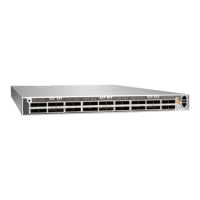CAUTION: Do not leave a ber-opc transceiver uncovered except when inserng or
removing cable. The safety cap keeps the port clean and prevents accidental exposure
to laser light.
5. Arrange the cable in the cable management system to prevent it from dislodging or developing stress
points. Secure the cable so that it is not supporng its own weight as it hangs to the oor. Place
excess cable out of the way in a neatly coiled loop in the cable management system. Placing
fasteners on the loop helps to maintain its shape.
CAUTION: Avoid bending ber-opc cable beyond its minimum bend radius. An arc
smaller than a few inches in diameter can damage the cable and cause problems that
are dicult to diagnose.
6. Pull the transceiver’s rubber handle straight back. The locking pins on the transceiver automacally
release. Place the transceiver on the anstac mat or in the electrostac bag.
Install a QSFP28 or QSFP56-DD Transceiver
To install a replacement QSFP28 or QSFP56-DD transceiver:
1. Aach an electrostac discharge (ESD) grounding strap to your bare wrist, and connect the strap to
one of the ESD points on the chassis.
2. Verify that a rubber safety cap covers the transceiver, installing one if necessary.
3. Orient the transceiver over the port so that the transceiver connector faces the appropriate
direcon.
4. Slide the transceiver into the slot unl the locking pins lock in place. If there is resistance, remove the
transceiver and ip it so that the connector faces the other direcon.
5. Remove the rubber safety cap from the transceiver and the end of the cable, and insert the cable into
the transceiver.
LASER WARNING: Do not look directly into a ber-opc transceiver or into the ends
of ber-opc cables. Fiber-opc transceivers and ber-opc cable connected to a
transceiver emit laser light that can damage your eyes.
116

